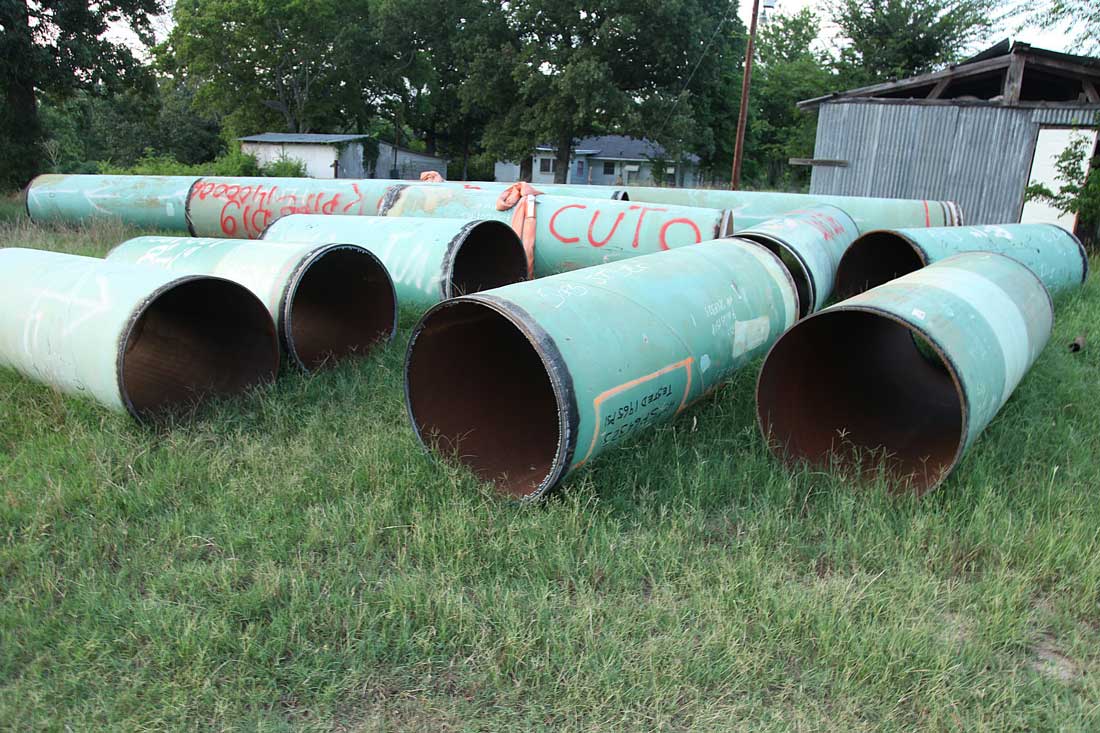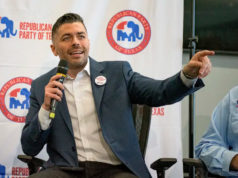TransCanada, the giant energy company building the southern leg of the Keystone XL pipeline from Cushing, Okla., to Port Arthur, claims its pipeline will be state of the art and environmentally safe, but some Texans are questioning that. In recent weeks, several dozen sections of pipe in an area around Winnsboro have had to be replaced because of problems relating to safety and reliability.
The pipeline replacement began in late May along the 60-mile East Texas segment after hydraulics tests showed faulty welds, dents, ruined pipe coating, and at least one section of pipe that was so bad the inspector who had it yanked simply labeled it “junk.”
“Let’s just say that it’s alarming and does not bode well for the integrity of their work,” said Ron Seifert, one of the organizers of the Tar Sands Blockade, a loosely knit group of activists trying to stop the pipeline. “For a supposedly state-of-the-art pipeline being dug up as frequently as three times per mile of pipe … well, that could indicate that corners are being cut.”
Shawn Howard, a TransCanada spokesman, wrote in an e-mail published on InsideClimateNews.org, a Pulitzer Prize-winning nonprofit website that opposes the pipeline, that nine sections of pipe, with a total length of about 81 feet, were being replaced. The project was recently renamed the Gulf Coast Pipeline.
Last week another company spokesman, David Dodson, said he didn’t know how much pipe was being replaced around Winnsboro. “We’re analyzing the data,” he said in an e-mail.
Gabe Cordoba took pictures of two sections of pipe pulled from his neighbor’s place in Winnsboro. “One of them is about 25 to 30 feet; the other about 40. So that’s almost the whole 81 feet right there,” he said. “The company says they’re just little dents, but look at the pictures, and you can see how mangled they are. One of them has a huge bow in it where it was bent to fit into a creekbed.”
Cordoba said he hasn’t been told whether any of the half-mile of pipe buried under his land in October will need to be replaced.
David Whitley, who owns 88 acres outside Winnsboro, said that only one section of pipe had to be replaced on his land. But Whitley also told Fort Worth Weekly that Michels Pipeline Construction is using an open spot near his land to hold two long sections of pipe that had been cut out. The pipe included one section of about 40 feet with the word “junk” written on it, Whitley said. Michels is a division of the company building the line for Transcanada.
Whitley said he has soured on the pipeline altogether. “When they called me up to say they needed to look at a section of the pipe they put in here, they said they were going to dig up a small section of the line and ‘visually inspect it.’ Those were the exact words the man used. He said they were just picking random places along the line to inspect. But then I started talking with other landowners and found out they had done testing and found defects at a lot of spots.”
The defect in Whitley’s section of line was apparently caused by a rock in the trench bed. “It was just the top of the rock sticking out, but it turned out to be a rock as big as a Volkswagen. You’d think they’d have checked the trench before they put the pipe in.”
The first sign of trouble with welds on the Keystone’s southern leg cropped up last Dec. 3, when two Tar Sands Blockaders locked themselves into a section of pipe that was ready to go into the ground. They quickly realized they could see sunlight through a weld in the pipe.
Photos of the faulty weld were first made public on Jan. 31 at a Pipetech Americas Summit in Houston, when blockader Ramsey Sprague, organizer of the Tarrant County Green Party, interrupted the event during a TransCanada speech on pipeline safety.
“You have to wonder what the chances are that the two blockaders wound up at a weld so faulty that sunlight could pass through it,” said Seifert. “I mean, was that the only faulty weld in the whole line? Let’s say that’s unlikely.”
Seifert pointed out that the 60-mile segment where dozens of sections are being replaced represents only a small portion of the project. “How much more bad pipe, how many more faulty welds will they find in the other 425 miles of line in Texas and Oklahoma?” he said.
Anthony Swift, an attorney with the Natural Resources Defense Council, called the whole TransCanada Keystone operation shoddy. The company’s Keystone 1 pipeline — running from Alberta, Canada, to Oklahoma, with another leg running to Illinois — had to be shut down by the federal Pipeline and Hazardous Materials Safety Administration “after a dozen spills in its first year,” Swift said. “Its Bison pipeline” — a natural gas line in Wyoming — “exploded. Two whistleblowers have stepped forward alleging systematic failures by the company to follow minimum safety standards. And now we’re seeing significant early problems with the southern section of Keystone XL.”
Dodson, the TransCanada spokesman, said the federal pipeline safety agency “really raised the bar” for the Keystone project. “We agreed to 57 additional conditions that no other pipeline has ever faced,” he said, including tighter tolerances that require pipe sections to be replaced more often than in the past. “It stands to reason that we’re going to find more anomalies in our line if we have a different standard than other lines,” he said.
Evan Volkes, one of the whistleblowers, was employed by TransCanada for several years as a materials engineer, working with pipe stress and welding. In testimony before the Canadian Senate, Volkes described what he said was “systemic negligence and malfeasance” in the corporation’s internal pipeline inspections.
“I’ve never seen anything as extensive as what is happening in Texas on the Keystone southern leg in terms of pipe replacement,” Volkes told the Weekly. “It’s simply shoddy construction practices to lay pipe on rocks. But that’s what happens when you don’t follow the American Society of Mechanical Engineers pipeline construction code.”
He scoffed at TransCanada’s claim that only nine sections of pipe were being replaced. “They’ve pulled more than nine sections of pipe from single properties,” he said.
Rita Beving, an activist with Public Citizen Texas, a public-interest advocacy group that frequently takes on environmental issues, said she had talked with landowners around Winnsboro and that she’s seen several properties where four or five sections of pipe are being replaced. “I’ve flown over the area south of there in a Cessna,” she said. “Dozens and dozens of pipe sections [are] being replaced.”
Mike Bishop, a landowner outside Winnsboro, said that he was told just last week that some anomalies have been found in the pipe on his land. “I don’t know how many sections of pipe they’ll need to change out. But I do know this is awfully shoddy work,” he said.
“So now they’ve got bad pipe in Texas that’s going to be carrying toxic tar sands bitumen that’s almost impossible to clean up, and they’re cleaning up the mess,” said Seifert. “I just don’t trust them to do that effectively.”













Of course there was a bend in the pipe! Those pipes are bent by the bending crew to fit the land to do the least amount of ecological damage. The creek was maintained because the pipe was bent to fit the surrounding land instead of the creek being totally changed!
And I think that if they are removing all the pipe that has “coating” issues or is not structurally sound that is a good thing! Do you actually think a company with shoddy work practices goes in and replaces (at their expense) work that isn’t up to standard?
I would rather they dig up every section of pipe if needed rather than leave it in place……